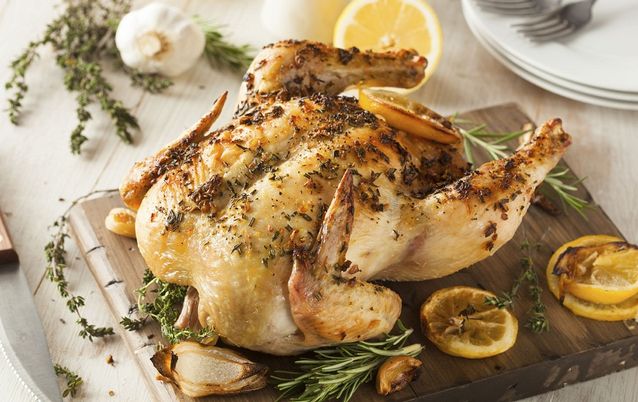THE eggs sit in a heated yellow box, the tops of their shells sliced off and replaced with cling film. Inside, translucent red bodies poke and press, alien-like, against the film.
These are some of the rarest chicken embryos, their DNA altered by scientists at Scotland’s Roslin Institute, an international centre of research on animal genetics.
"They’ll hatch tomorrow," says Prof Helen Sang, a geneticist who has spent much of her career perfecting techniques for the genetic modification of chickens.
Famous for creating Dolly the sheep, the first cloned mammal, in 1996, Roslin is at the forefront of research into chicken genetics, and houses about 1,700 genetically bespoke birds. Once the chicks hatch, they will spend their lives in a big shed on the institute’s sprawling rural campus just outside Edinburgh, where they will be observed and tested to see how they differ from their natural peers.
Adult birds are placed in spacious wooden pens; one contains hens whose eggs include a new protein that is being tested as a potential treatment for liver damage. Other genetically modified chicks at Roslin have had their immune cells tagged with a fluorescent protein so that after their death scientists can see where invading microbes have clustered. Still other birds contain an extra gene that interrupts the transmission of avian flu.
While the "superchickens" have not been developed to be eaten, they represent "proof of concept", as Sang put it to a 2004 British parliamentary committee. She believes their successors might one day make it to the dinner table.
At least 50-billion birds worldwide are reared each year for their meat and another 5-billion are kept as laying hens, according to the International Egg Commission, which represents the egg industry.
But feeding the fondness for chicken and eggs is a challenge as population levels rise and higher incomes in developing economies mean more people can afford to put meat on the table.
Poultry, which includes turkeys, ducks and geese, accounts for about 35% of all meat eaten globally, and is soon predicted to overtake pork, now at 36%. Chicken is the cheapest, most accessible meat, low in fat and with a relatively modest carbon footprint. There are few taboos around its consumption.
The aim is to tackle some of the pressing issues in animal health and welfare, "their implications for human health and for the role of animals in the food chain".
The food industry would like to breed chickens more efficiently, while emitting less methane and using fewer antibiotics. It also wants to produce high-quality, disease-free eggs, while satisfying consumer demand for better animal welfare.
The long-term plan of Sang and her team is to develop a healthier genetic blueprint for a bird whose physiology has suffered over decades of selective breeding. By creating a more resilient chicken, they hope to help producers meet the rise in global demand without sacrificing animal wellbeing.
"Our ultimate goal is to improve the chicken, and to improve the lot of the chicken," says Sang.
Today’s commercially bred chickens look far bulkier than did their puny forebears from a century ago. After the Second World War, consumers craved cheap protein. Breeders selected birds for meatiness without always getting, or preserving, the genes for strong bones. Now there are too many broilers (chickens bred for meat) propped up by brittle skeletons and serviced by overworked hearts.
...
THE animal welfare charity Peta says the average breast of an eight-week-old chicken is seven times heavier than 25 years ago.
"I don’t think people understand how successful poultry-breeding genetics has been in changing the characteristics of chickens since the Second World War," says Sang.
All those changes were wrought by selective breeding, which means picking out animals with the desired characteristics and mating them.
Now firms such as Aviagen, Hy-Line and Cobb-Vantress, which sell trademarked pedigree breeds used to produce millions of supermarket birds, have realised that science can replace pedigree information with genome information.
The British Poultry Council says selective breeding programmes can target 40 characteristics that fall under genetic influence, from bone health and the oxygen-carrying capacity of blood to food efficiency and growth rate.
Some traits are controlled by multiple rather than single genes; to identify which are responsible for which traits, companies and researchers must sequence the genes of thousands of birds. Each bird is assigned a "breeding value".
The modern science of poultry genetics is likely to revive interest in old or rare breeds, which may constitute reservoirs of useful gene variants. Dr John Hickey, a quantitative geneticist at Roslin who grew up in Ireland on a sheep and cattle farm, specialises in this field.
"My task is to sequence the genomes of 289,000 birds, for which we already have detailed pedigree information. That’s exciting because it allows us to unravel the biology of traits much more precisely," he says.
Hickey, who worked with plant breeders in Mexico, says science has always helped us to fulfil our carnivorous aspirations.
"With the chicken genetics of the 1950s, every tonne of feed produced 330kg of chicken meat. Today it produces 580kg. Without that progress, we would need twice the agricultural land to produce the meat we have today," he says.
The industry now wants to push that efficiency further. Individual chickens process food slightly differently. Geneticists want to selectively breed those that can thrive on lower amounts of feed.
Rising world grain prices have prompted research into birds that can stay healthy even with lower-quality feed, such as dried distiller’s grains with solubles, a byproduct of the fermentation process used in brewing. Europe tends to feed its chickens on wheat, while the US uses maize. Scientists argue that these high-quality grains could feed people instead.
Some academics believe raising meat production to feed the world is misguided. "It doesn’t make sense, from the perspective of either human health or sustainability, to increase meat production to meet rising demand," says Lynn Frewer, professor of food and society at Newcastle University.
"An alternative strategy might be to encourage people to adopt diets that contain proteins from legumes and fungi, which take a fraction of the resources required to produce meat. I’m not arguing for a vegetarian world, but we need to consider lots of options and not a single response to food security with respect to protein."
Avian biologist Dr Ian Dunn is a bird lover who plans to keep chickens when he retires. He works in an office plastered with pictures of chickens and regards the laboratory birds with affection.
"For every bird you eat, there needs to be an egg. People don’t think about that," he says. "You need to have huge hatcheries. The whole industry depends on science."
His brief is to solve the egg industry’s problems. The big ones are poor bone-health in laying hens, and bacterial infections — antibiotic-resistant E.coli and salmonella can be passed from mother to chick, and into breeding lines.
...
COMMERCIALLY bred hens lay for up to 300 days of the year, a process that literally requires the shelling out of a lot of calcium (in the wild, hens produce up to 30 eggs a year).
This heavy-laying schedule renders them prone to osteoporosis, a condition that can be detected definitively only during a post-mortem — too late to ensure that future layers are descended from strong-boned stock.
Dunn’s team at Roslin has identified a genetic marker for good bones that can be applied when the hen is alive.
The bacterial research focuses on the cuticle, a thin protein layer that covers the outside of the egg. The thicker the cuticle, the greater its resistance to bacteria.
Dunn, working with colleagues at Roslin and elsewhere, has shown that cuticle-formation is partly controlled by genes.
This paves the way for selectively breeding chickens able to lay down strong cuticles, which block out pathogens such as salmonella.
There is a third area of interest: weaning birds off antibiotics.
"Because of the rise of resistance, the poultry of the future will have to manage without the antibiotics that humans use," says Dunn. "So, we are now looking at the microbiome."
The microbiome is the balance of microbes in a bird’s gut, passed on in the egg. The Roslin team has isolated valuable microbe-killing chemicals from eggs laid by hens with good microbiomes; enriching chicken feed with these chemicals, called ovodefensins, has resulted in better gut health for the birds.
Despite having worked with chickens for decades, Dunn remains fascinated by them.
"There are so many interesting aspects to their biology, such as the fact that an egg is produced externally, and the way egg-formation is controlled. It’s not a unique biology, but it’s helped to make chickens world-dominating."
...
ROSLIN scientists know that there is a distinct lack of consumer appetite for genetically modified products in the food chain and, correspondingly, a lack of commercial interest, even though genetic-engineering may be the easiest and quickest way of packing desirable traits into a bespoke über-bird.
Cobb-Vantress, which announced in 2014 that it was putting almost $1m into a three-year research programme at Roslin, says that while it helped fund the institute’s work on developing a bird that would block the spread of avian flu, the company has chosen not to pursue commercialisation of that technology "at this time".
An alternative to genetic modification is gene-editing, also called genome-editing, which is a revolutionary and much more precise cut-and-paste method of working with DNA.
Hickey argues that there is an ethical imperative behind the development of genetically modified chickens. "If chickens could be produced more efficiently, more people could eat them. You could argue we have a moral responsibility to meet that demand — or are we going to deny children in Africa access to animal protein?" he asks.
"It is very, very difficult to eat a properly nutritious plant-based diet. In the future, genetically modified food might be the only ethical food to eat."
Timothy Lang, professor of food policy at City University in London and a former farmer in Lancashire, salutes Roslin’s genetic wizardry, but insists "the developing world doesn’t need hi-tech chickens.
"While there is a case for meat (in the diet), the issue is how much and how it’s produced. We are overconsuming, distorting our land use, and using 40%-50% of (the world’s) cereals to feed our animals, which is disgraceful.
"We should be decelerating the treadmill of meat-consumption and production, not spinning the wheels of industrialisation faster."
In the US, the debate about genetically engineered protein has become pressing. In November last year, the Food and Drug Administration endorsed genetically modified salmon for human consumption, the first approval for a genetically modified fish or meat product.
The modifications mean the salmon grows to market size in 18 months rather than three years. Despite Food and Drug Administration approval, several grocery chains have refused to stock the transgenic fish — and consumer groups want it labelled as genetically modified, something the administration has not yet insisted upon.
Genetically modified chickens are also unlikely to migrate from the laboratory to supermarket shelves in the near future, if at all.
But modern genetics can still inform breeding methods: knowing the genes of individual birds allows particular specimens to be conventionally cross-bred with more speed and precision, which is a bit like mixing individual paints to achieve a perfect hue.
Sang acknowledges that the public may not yet be ready to welcome her "superchicks" as part of the food chain. "We don’t go out and sell our genetically modified chickens," she says.
"Our job," the genetic trailblazer adds, "is to show what technologies are useful but, ultimately, the breeders and society have to decide whether they want them."
© Financial Times Limited 2016
-

Humans, by and large, are not ready to welcome genetically modified chickens as part of the food chain, but scientists hold strong counterarguments. Picture: ISTOCK
-

Poultry accounts for about 35% of all meat eaten globally, and is soon predicted to overtake pork, which is now at 36%. Picture: ISTOCK
THE eggs sit in a heated yellow box, the tops of their shells sliced off and replaced with cling film. Inside, translucent red bodies poke and press, alien-like, against the film.
These are some of the rarest chicken embryos, their DNA altered by scientists at Scotland’s Roslin Institute, an international centre of research on animal genetics.
"They’ll hatch tomorrow," says Prof Helen Sang, a geneticist who has spent much of her career perfecting techniques for the genetic modification of chickens.
Famous for creating Dolly the sheep, the first cloned mammal, in 1996, Roslin is at the forefront of research into chicken genetics, and houses about 1,700 genetically bespoke birds. Once the chicks hatch, they will spend their lives in a big shed on the institute’s sprawling rural campus just outside Edinburgh, where they will be observed and tested to see how they differ from their natural peers.
Adult birds are placed in spacious wooden pens; one contains hens whose eggs include a new protein that is being tested as a potential treatment for liver damage. Other genetically modified chicks at Roslin have had their immune cells tagged with a fluorescent protein so that after their death scientists can see where invading microbes have clustered. Still other birds contain an extra gene that interrupts the transmission of avian flu.
While the "superchickens" have not been developed to be eaten, they represent "proof of concept", as Sang put it to a 2004 British parliamentary committee. She believes their successors might one day make it to the dinner table.
At least 50-billion birds worldwide are reared each year for their meat and another 5-billion are kept as laying hens, according to the International Egg Commission, which represents the egg industry.
But feeding the fondness for chicken and eggs is a challenge as population levels rise and higher incomes in developing economies mean more people can afford to put meat on the table.
Poultry, which includes turkeys, ducks and geese, accounts for about 35% of all meat eaten globally, and is soon predicted to overtake pork, now at 36%. Chicken is the cheapest, most accessible meat, low in fat and with a relatively modest carbon footprint. There are few taboos around its consumption.
The aim is to tackle some of the pressing issues in animal health and welfare, "their implications for human health and for the role of animals in the food chain".
The food industry would like to breed chickens more efficiently, while emitting less methane and using fewer antibiotics. It also wants to produce high-quality, disease-free eggs, while satisfying consumer demand for better animal welfare.
The long-term plan of Sang and her team is to develop a healthier genetic blueprint for a bird whose physiology has suffered over decades of selective breeding. By creating a more resilient chicken, they hope to help producers meet the rise in global demand without sacrificing animal wellbeing.
"Our ultimate goal is to improve the chicken, and to improve the lot of the chicken," says Sang.
Today’s commercially bred chickens look far bulkier than did their puny forebears from a century ago. After the Second World War, consumers craved cheap protein. Breeders selected birds for meatiness without always getting, or preserving, the genes for strong bones. Now there are too many broilers (chickens bred for meat) propped up by brittle skeletons and serviced by overworked hearts.
...
THE animal welfare charity Peta says the average breast of an eight-week-old chicken is seven times heavier than 25 years ago.
"I don’t think people understand how successful poultry-breeding genetics has been in changing the characteristics of chickens since the Second World War," says Sang.
All those changes were wrought by selective breeding, which means picking out animals with the desired characteristics and mating them.
Now firms such as Aviagen, Hy-Line and Cobb-Vantress, which sell trademarked pedigree breeds used to produce millions of supermarket birds, have realised that science can replace pedigree information with genome information.
The British Poultry Council says selective breeding programmes can target 40 characteristics that fall under genetic influence, from bone health and the oxygen-carrying capacity of blood to food efficiency and growth rate.
Some traits are controlled by multiple rather than single genes; to identify which are responsible for which traits, companies and researchers must sequence the genes of thousands of birds. Each bird is assigned a "breeding value".
The modern science of poultry genetics is likely to revive interest in old or rare breeds, which may constitute reservoirs of useful gene variants. Dr John Hickey, a quantitative geneticist at Roslin who grew up in Ireland on a sheep and cattle farm, specialises in this field.
"My task is to sequence the genomes of 289,000 birds, for which we already have detailed pedigree information. That’s exciting because it allows us to unravel the biology of traits much more precisely," he says.
Hickey, who worked with plant breeders in Mexico, says science has always helped us to fulfil our carnivorous aspirations.
"With the chicken genetics of the 1950s, every tonne of feed produced 330kg of chicken meat. Today it produces 580kg. Without that progress, we would need twice the agricultural land to produce the meat we have today," he says.
The industry now wants to push that efficiency further. Individual chickens process food slightly differently. Geneticists want to selectively breed those that can thrive on lower amounts of feed.
Rising world grain prices have prompted research into birds that can stay healthy even with lower-quality feed, such as dried distiller’s grains with solubles, a byproduct of the fermentation process used in brewing. Europe tends to feed its chickens on wheat, while the US uses maize. Scientists argue that these high-quality grains could feed people instead.
Some academics believe raising meat production to feed the world is misguided. "It doesn’t make sense, from the perspective of either human health or sustainability, to increase meat production to meet rising demand," says Lynn Frewer, professor of food and society at Newcastle University.
"An alternative strategy might be to encourage people to adopt diets that contain proteins from legumes and fungi, which take a fraction of the resources required to produce meat. I’m not arguing for a vegetarian world, but we need to consider lots of options and not a single response to food security with respect to protein."
Avian biologist Dr Ian Dunn is a bird lover who plans to keep chickens when he retires. He works in an office plastered with pictures of chickens and regards the laboratory birds with affection.
"For every bird you eat, there needs to be an egg. People don’t think about that," he says. "You need to have huge hatcheries. The whole industry depends on science."
His brief is to solve the egg industry’s problems. The big ones are poor bone-health in laying hens, and bacterial infections — antibiotic-resistant E.coli and salmonella can be passed from mother to chick, and into breeding lines.
...
COMMERCIALLY bred hens lay for up to 300 days of the year, a process that literally requires the shelling out of a lot of calcium (in the wild, hens produce up to 30 eggs a year).
This heavy-laying schedule renders them prone to osteoporosis, a condition that can be detected definitively only during a post-mortem — too late to ensure that future layers are descended from strong-boned stock.
Dunn’s team at Roslin has identified a genetic marker for good bones that can be applied when the hen is alive.
The bacterial research focuses on the cuticle, a thin protein layer that covers the outside of the egg. The thicker the cuticle, the greater its resistance to bacteria.
Dunn, working with colleagues at Roslin and elsewhere, has shown that cuticle-formation is partly controlled by genes.
This paves the way for selectively breeding chickens able to lay down strong cuticles, which block out pathogens such as salmonella.
There is a third area of interest: weaning birds off antibiotics.
"Because of the rise of resistance, the poultry of the future will have to manage without the antibiotics that humans use," says Dunn. "So, we are now looking at the microbiome."
The microbiome is the balance of microbes in a bird’s gut, passed on in the egg. The Roslin team has isolated valuable microbe-killing chemicals from eggs laid by hens with good microbiomes; enriching chicken feed with these chemicals, called ovodefensins, has resulted in better gut health for the birds.
Despite having worked with chickens for decades, Dunn remains fascinated by them.
"There are so many interesting aspects to their biology, such as the fact that an egg is produced externally, and the way egg-formation is controlled. It’s not a unique biology, but it’s helped to make chickens world-dominating."
...
ROSLIN scientists know that there is a distinct lack of consumer appetite for genetically modified products in the food chain and, correspondingly, a lack of commercial interest, even though genetic-engineering may be the easiest and quickest way of packing desirable traits into a bespoke über-bird.
Cobb-Vantress, which announced in 2014 that it was putting almost $1m into a three-year research programme at Roslin, says that while it helped fund the institute’s work on developing a bird that would block the spread of avian flu, the company has chosen not to pursue commercialisation of that technology "at this time".
An alternative to genetic modification is gene-editing, also called genome-editing, which is a revolutionary and much more precise cut-and-paste method of working with DNA.
Hickey argues that there is an ethical imperative behind the development of genetically modified chickens. "If chickens could be produced more efficiently, more people could eat them. You could argue we have a moral responsibility to meet that demand — or are we going to deny children in Africa access to animal protein?" he asks.
"It is very, very difficult to eat a properly nutritious plant-based diet. In the future, genetically modified food might be the only ethical food to eat."
Timothy Lang, professor of food policy at City University in London and a former farmer in Lancashire, salutes Roslin’s genetic wizardry, but insists "the developing world doesn’t need hi-tech chickens.
"While there is a case for meat (in the diet), the issue is how much and how it’s produced. We are overconsuming, distorting our land use, and using 40%-50% of (the world’s) cereals to feed our animals, which is disgraceful.
"We should be decelerating the treadmill of meat-consumption and production, not spinning the wheels of industrialisation faster."
In the US, the debate about genetically engineered protein has become pressing. In November last year, the Food and Drug Administration endorsed genetically modified salmon for human consumption, the first approval for a genetically modified fish or meat product.
The modifications mean the salmon grows to market size in 18 months rather than three years. Despite Food and Drug Administration approval, several grocery chains have refused to stock the transgenic fish — and consumer groups want it labelled as genetically modified, something the administration has not yet insisted upon.
Genetically modified chickens are also unlikely to migrate from the laboratory to supermarket shelves in the near future, if at all.
But modern genetics can still inform breeding methods: knowing the genes of individual birds allows particular specimens to be conventionally cross-bred with more speed and precision, which is a bit like mixing individual paints to achieve a perfect hue.
Sang acknowledges that the public may not yet be ready to welcome her "superchicks" as part of the food chain. "We don’t go out and sell our genetically modified chickens," she says.
"Our job," the genetic trailblazer adds, "is to show what technologies are useful but, ultimately, the breeders and society have to decide whether they want them."
© Financial Times Limited 2016





















Change: -1.54%
Change: -1.49%
Change: -2.02%
Change: -0.73%
Change: -4.01%
Data supplied by Profile Data
Change: -0.18%
Change: -0.26%
Change: -1.54%
Change: 0.00%
Change: -0.34%
Data supplied by Profile Data
Change: 0.86%
Change: 0.30%
Change: 0.68%
Change: 0.82%
Change: 0.12%
Data supplied by Profile Data
Change: -2.24%
Change: -3.72%
Change: -3.78%
Change: -3.81%
Change: -1.76%
Data supplied by Profile Data